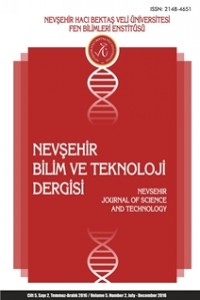The Welding of TRIP Steel with Different Si Contents by Mig-Mag Welding Technique and Its Microstructure Investigation
Öz
In this study, TRIP (Transformation
Induced Plasticity) steel production with different Si content carried out by
adding Si in TRIP steel with using non-vacuum induction furnace. Typical TRIP
steel contains 0.2 wt % C, 1.7 Mn 1.5 Si. Al content of the steel was changed
to 0,6 – 1,15 - 1,7 ratios. After then, the rolled specimens were joined by robotic Gas-Metal
Arc Welding (GMAW) technique. Hence, the
weldability of the different Si content into the TRIP was investigated. For this purpose, the microstructures
of the weld region were investigated and hardness profile achieved by being
done micro-hardness analysis of the samples taken from the weld cross section.
Anahtar Kelimeler
Kaynakça
- [1] Taş Z., Relationship of microstructural–mechanical features in Nb-V alloyed boron steels, Erciyes University Journal of Science Institute, 160 (2006), 22:52.
- [2] Meyer L, Straburger C., Schneider C., Effect and present application of the microalloying elements Nb, V, Ti, Zr, and B in HSLA steels, HSLA steels: metallurgy and applications (1985), 29-45.
- [3] Cohen, M., Hansen S. S., On the fundamentals of HSLA steels, HSLA steels: metallurgy and applications, (1985), 61-73.
- [4] Koyama R., Tsukamoto T., Boron-added steel, Simitomo Metals, 48 (1996), 195-197. [5] Masakatsu U., Hardenability of low-carbon steel and boron, Research Review on Boron in Steels and Targets for Next Century, (1999), 78-86.
- [6] Tomoya F., Hardenability improvement effect of the boron in TMCP, Research Review on Boron in Steels and Targets for Next Century, (1999), 68-72.
- [7] Fountain, R. W., Chipman J., Solubility and precipitation of boron nitride in iron-boron alloys, Transactions of the metallurgical society of AIME, 224(1962), 599-605.
- [8] Ohmori Y., The isothermal decomposition of an Fe-C-B austenite, Transactions ISIJ, 11 (1971), 339-348.
- [9] Melloy G. F., Slimmon P. P., Podgursky P. P., Optimizing the boron effect. Metallurgical Transactions, 4 (1973), 2279-2289.
- [10] Lewellyn D. T., Cook W. T., Metallurgy of boron-treated low-alloy steel, Metals Technology, (1974), 517-529.
- [11] Malinochka Y. N., Koval’chuk G. Z., Yarmosh V. N., Structure and properties of low-carbon steel alloyed with boron and copper, Translated from Metallovedenie Termicheskaya Obrabotka Metallov, 11 (1982), 10-14.
- [12] Paju M., Hougardy H. P., Grabke H. J., Effects of boron alloying on the properties of a low-carbon low-alloying steel, Scandinavian Journal of Metallurgy, 18 (1989), 235-242.
- [13] Taylor K. A., Hansen S. S., The boron hardenability effect in thermomechanically processed, direct-quenched 0,2 Pct steels, Metallurgical Transactions, 21 (1990), 1697-1708.
- [14] Carboga C., Effect of addition on microstructure and mechanical properties of low carbon steels, Gazi University The Instıtute of Science and Technology, (2010), 1-220.
Farklı Oranlarda Si İçeren TRIP Çeliğinin Mig-Mag Kaynak Tekniği İle Kaynağı ve Mikroyapısının İncelenmesi
Öz
Bu çalışmada,
tipik TRIP (Transformation Induced Plasticity) çeliğinin mevcut silisyum
miktarı değiştirilerek vakumsuz indüksiyon ocağında farklı Si içeriğine sahip
TRIP çeliği üretimi gerçekleştirilmiştir. Tipik TRIP çeliği % ağırlıkça 0,2 C,
1,7 Mn, 1,5 Si içermektedir. Üretimi gerçekleştirilen TRİP çeliğinin Si oranı ise
0,6 – 1,15 - 1,7 oranlarında değiştirilmiştir. Döküm ve haddeleme işlem
sonrasında, MİG-MAG kaynak tekniği kullanılarak birleştirilmiştir. Böylece,
farklı oranda Si içeren TRIP çeliğinin kaynak edilebilirliği araştırılmıştır.
Bu amaçla, kaynak bölgesinin mikroyapısı incelenmiş ve kaynak bölgesi
kesitinden mikrosertlik analizleri alınarak sertlik profili çıkarılmıştır.
Anahtar Kelimeler
Kaynakça
- [1] Taş Z., Relationship of microstructural–mechanical features in Nb-V alloyed boron steels, Erciyes University Journal of Science Institute, 160 (2006), 22:52.
- [2] Meyer L, Straburger C., Schneider C., Effect and present application of the microalloying elements Nb, V, Ti, Zr, and B in HSLA steels, HSLA steels: metallurgy and applications (1985), 29-45.
- [3] Cohen, M., Hansen S. S., On the fundamentals of HSLA steels, HSLA steels: metallurgy and applications, (1985), 61-73.
- [4] Koyama R., Tsukamoto T., Boron-added steel, Simitomo Metals, 48 (1996), 195-197. [5] Masakatsu U., Hardenability of low-carbon steel and boron, Research Review on Boron in Steels and Targets for Next Century, (1999), 78-86.
- [6] Tomoya F., Hardenability improvement effect of the boron in TMCP, Research Review on Boron in Steels and Targets for Next Century, (1999), 68-72.
- [7] Fountain, R. W., Chipman J., Solubility and precipitation of boron nitride in iron-boron alloys, Transactions of the metallurgical society of AIME, 224(1962), 599-605.
- [8] Ohmori Y., The isothermal decomposition of an Fe-C-B austenite, Transactions ISIJ, 11 (1971), 339-348.
- [9] Melloy G. F., Slimmon P. P., Podgursky P. P., Optimizing the boron effect. Metallurgical Transactions, 4 (1973), 2279-2289.
- [10] Lewellyn D. T., Cook W. T., Metallurgy of boron-treated low-alloy steel, Metals Technology, (1974), 517-529.
- [11] Malinochka Y. N., Koval’chuk G. Z., Yarmosh V. N., Structure and properties of low-carbon steel alloyed with boron and copper, Translated from Metallovedenie Termicheskaya Obrabotka Metallov, 11 (1982), 10-14.
- [12] Paju M., Hougardy H. P., Grabke H. J., Effects of boron alloying on the properties of a low-carbon low-alloying steel, Scandinavian Journal of Metallurgy, 18 (1989), 235-242.
- [13] Taylor K. A., Hansen S. S., The boron hardenability effect in thermomechanically processed, direct-quenched 0,2 Pct steels, Metallurgical Transactions, 21 (1990), 1697-1708.
- [14] Carboga C., Effect of addition on microstructure and mechanical properties of low carbon steels, Gazi University The Instıtute of Science and Technology, (2010), 1-220.
Ayrıntılar
| Konular | Mühendislik |
|---|---|
| Bölüm | Malzeme Mühendisliği |
| Yazarlar | |
| Yayımlanma Tarihi | 30 Aralık 2017 |
| Kabul Tarihi | 27 Aralık 2017 |
| Yayımlandığı Sayı | Yıl 2017 Cilt: 6 Sayı: 2 |

